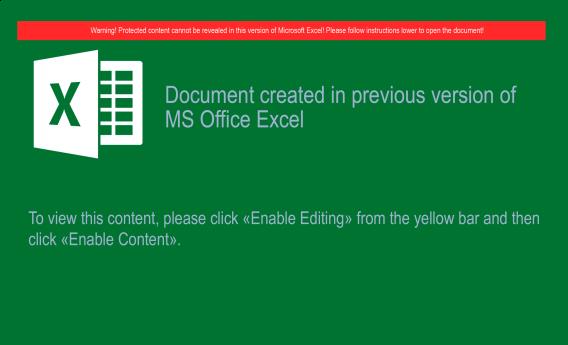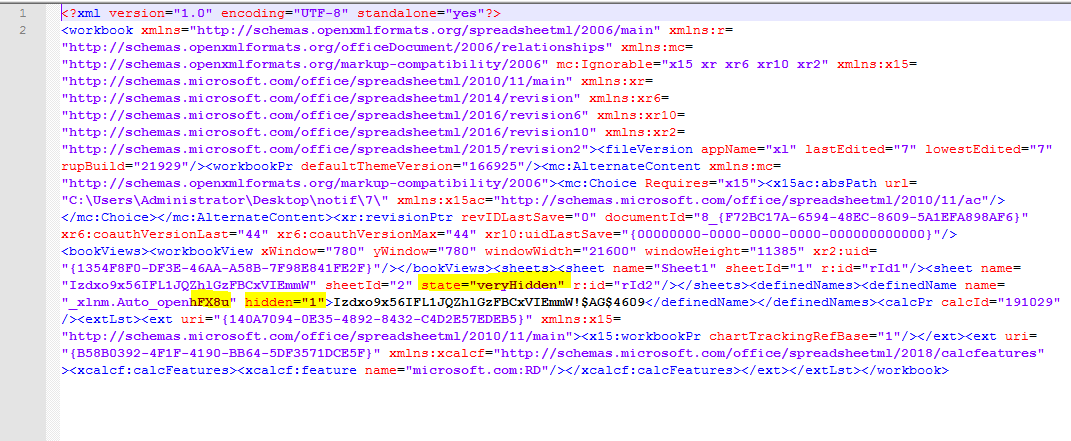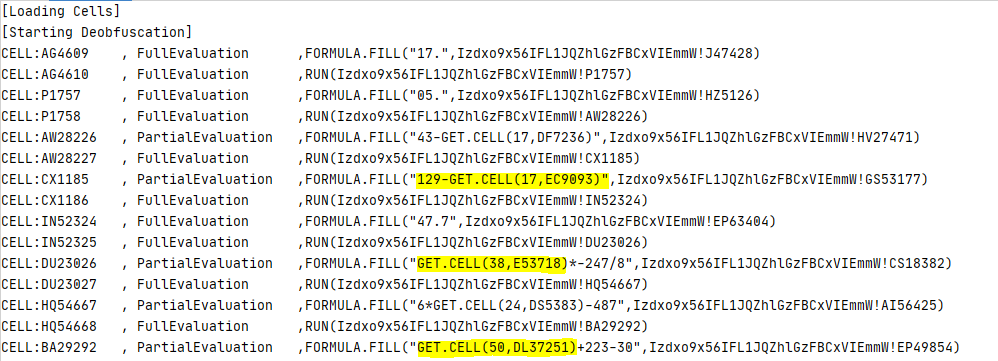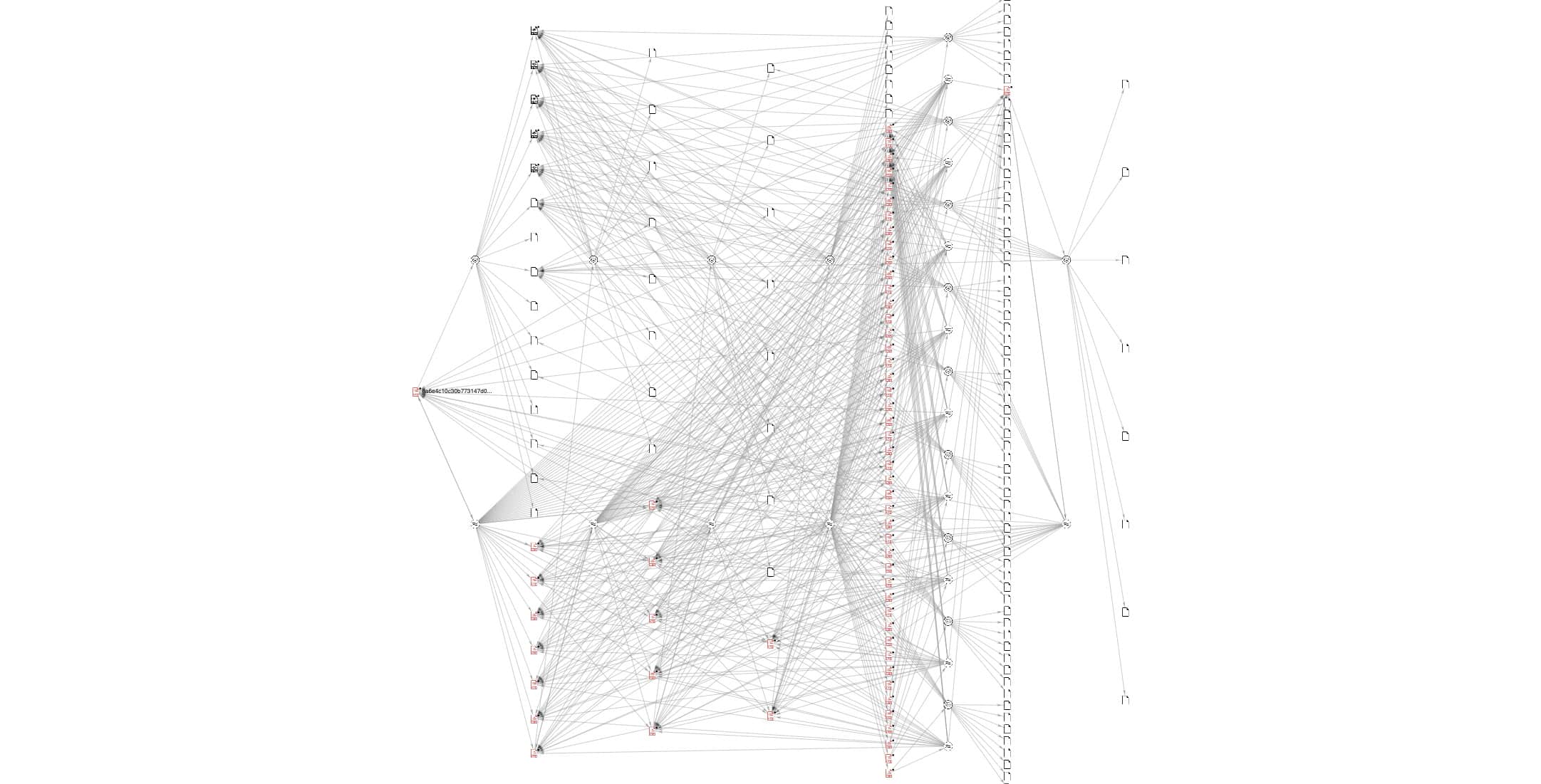In January of 2019, we published a blog titled “Extracting ‘Sneaky’ Excel XLM Macros” that detailed a technique attackers had adopted for embedding malicious logic under a less understood facet of Excel Spreadsheets, Excel 4.0 macros aka XLM macros. In March of this year, we published “Getting Sneakier: Hidden Sheets, Data Connections, and XLM Macros”, that evolved the stealthiness of the approach through the remote embedding of later-stage content via Excel DCONN records. Today, we uncover yet another iteration on this tactic. We are examining a novel and advanced obfuscation scheme with macrosheets embedded in the (newer) Office 2007+ format, versus the legacy OLE format (Object Linking and Embedding).
Initial Samples, Low Detection Rates
Tracing back through recent history, the first sample we’re able to identify from this campaign appeared on VirusTotal on Monday, May 4th (Star Wars Day): InQuest Labs: 955d59e66e24b4585dd044b1576f03ff0e6d8306397766420806979475eededd VirusTotal: 1/58 Detection rates for this and all related samples is rather abysmal, with decent coverage coming from just a single vendor, Qihoo-360, identifying the threat as Macro.office.07defname.gen. While this sample was the earliest, the first sample that caught our eye, and the primary one we’ll be examining below is: * 8a6e4c10c30b773147d0d7c8307d88f1cf242cb01a9747bfec0319befdc1fcaf You can download this sample to follow along yourself through our open data portal, InQuest Labs. Let’s start by highlighting the “hidden” / “very-hidden” sheets and obfuscated AutoOpen hook from xl/workbook.xml:
<sheets>
<sheet name="Sheet1" sheetId="1" r_id="rId1"/>
<sheet name="Izdxo9x56IFL1JQZhlGzFBCxVIEmmW" sheetId="2" state="veryHidden" r_id="rId2"/>
</sheets>
<definedNames>
<definedName name="_xlnm.Auto_openhFX8u" hidden="1">Izdxo9x56IFL1JQZhlGzFBCxVIEmmW!$AG$4609</definedName>
</definedNames>The Microsoft Office suite provides a large, feature-rich, backwards compatible, and ever-changing landscape for malicious actors to discover and leverage new threat tactics. Weighing in at 10’s of millions of lines and countless installations globally, it’s not hard to see why attackers favor the platform. This novel tactic for pivoting to the execution of embedded logic is the latest in a long and seemingly never-ending trail of successful creativity.
An Effective Detection Anchor
One consistency among non-exploit-based malware lures is the need to coerce the target into enabling the execution pivot. The requirement for user consent is a double-edged sword. On the one hand, it reduces the immediate impact of the threat. On the other, multiple interactions (consider the DDE based command execution tactic from 2017) can result in lower detection rates. A common tactic that has remained consistent for years is the usage of embedded media to coerce the target user into taking a wary action. This campaign is no different; here’s an example sourced from xl/media/image1.jpg:

Notice the feint green-on-green coloring and low image fidelity. Undoubtedly designed to bypass attempts at Optical Character Recognition (OCR). The choice of JPG over PNG for this image would make a graphic designer cringe, but the lossy format plays to the attackers favor. It’s prudent for us to note that InQuest OCR is more than capable of discerning accurate text and producing an alert on the image alone. We can search InQuest Labs for samples that trigger our coercion heuristics. From a sampling of lures associated with this campaign, here is the breakdown of embedded image hashes:
Key|Ct (Pct) Histogram
6b435bbf9b254681dafd6abf783632ac|10 (13.16%) -----------------------------------
667de8e48255ae7183077b889a271c1e| 8 (10.53%) ----------------------------
d98d763d6ca4f1c736b3fbc163669224| 7 (9.21%) ------------------------
d59b82fd9504ba9b130c0d048b492a10| 6 (7.89%) ---------------------
cdb3950c2a0e342c793ccdc1eb566803| 5 (6.58%) ------------------
98e8cd0a87fb4f3549a15c1e52043df4| 5 (6.58%) ------------------
879ee929dd80ff750e442e3e0befda6b| 4 (5.26%) --------------
63282400dbdeb0dc7382bd86d768cfd7| 4 (5.26%) --------------
4a20b2d5bb46837bae61d73291712319| 4 (5.26%) --------------
444520d98f7fe4b6dd0da106ab87a1fb| 4 (5.26%) --------------
075356a385451f7a14d7322cd334f2b7| 4 (5.26%) --------------
fa9dbfda5aebfd3d4a8b4c198e38e4bb| 3 (3.95%) -----------
dd607e4daa5b52d1cc0353bf484296e4| 3 (3.95%) -----------
2764db07e1a670674a65b9f7c3417487| 3 (3.95%) -----------
01ef5c035ec3aa501b9ab085e862a34f| 3 (3.95%) -----------Intelligently, the attackers have decided to modify the image dimensions slightly to reduce detection exposure on the media asset. This is a less commonly seen tactic, let’s explore the most common images by dimension (instead of cryptographic hash):
Key|Ct (Pct) Histogram
574x345|29 (38.16%) ------------------------------------------------------------
579x345|20 (26.32%) -----------------------------------------
568x345|13 (17.11%) ---------------------------
563x345| 8 (10.53%) -----------------
585x345| 4 (5.26%) ---------
607x361| 1 (1.32%) ---
385x393| 1 (1.32%) ---
We can see more overlap with this “fuzzier” approach. This extra step taken by the operators to evade detection shows an increased level of sophistication, especially when you consider that many attackers leave valuable XMP identifiers in their graphical assets that can be used as a fast/ accurate detection anchor, as well as a pivot point for mapping relationships between samples. Browsing the graphics embedded in the variety of captured samples, they’re all the same with the exception of that last one (385×393), which belongs to sample e468618f7c42c2348ef72fb3a733a1fe3e6992d742f3ce2791f5630bc4d40f2a and carries the following image:

Apparently a “roflanbuldiga“? @RoflanB. No conclusions can or have been drawn from this graphical asset, it’s just interesting to note. In the next section we’ll take a glance at some of the novel obfuscation tactics employed by this campaign to deter detection.
Obfuscated Macrosheet
Download either the extracted macrosheet with XML tags stripped, or, a trivially reformatted version that we’ve prepared to ease readability:
- XML stripped macrosheet: 8a6e4c10c30b773147d0d7c8307d88f1cf242cb01a9747bfec0319befdc1fcaf
- Formatted macrosheet: 8a6e4c10c30b773147d0d7c8307d88f1cf242cb01a9747bfec0319befdc1fcaf.formatted
There are several interesting obfuscation techniques that are used to evade detection and also complicate automated / manual deobfuscation processes.

The macrosheet is flagged as veryHidden (recall from our previous blog that the BIFF file format supports binary level flags for hidden and very-hidden) and contains a defined name that will execute automatically on open _xlnm.Auto_openhFX8u, this is different than the familiar auto_open and related derivatives. Defenders should note that these names are NOT case-sensitive and that regardless of what suffix is appended to the defined name, Microsoft Excel will autostart the embedded logic. Digging further, note the following:

It relies on FORMULA.FILL() to generate code. After each <code>FORMULA.FILL()</code> we have a “jump” through usage of the RUN< function. While still under active development and not currently supporting all the features of this sample, usage of XLMMacroDeobfuscator can assist us in dissecting further:

The code first fills several cells with a few numbers derived from the current date (NOW()) and the properties of several cells such as their height or their font color (GET.CELL()). For example, GET.CELL(17, EC9093) returns the height of the row which cell EC9093 resides on (i.e., row 9093). To learn more about GET.CELL() take a look at this Excel 4.0 Functions Reference. The first cell that contains the obfuscated formula is AK47754:

To deobfuscate each character of the formula, the macrosheet logic performs calculations based on two cell values, the value of one cell is already there, the value of the other one calculated based on the current date or some properties of the other cells. In previous samples, they relied only on one calculated value (current date or properties of some cells) to decode all the characters in one formula. As a result, if we could guess what would be one of the deobfuscated characters in the formula, we could find out the calculated value. In fact, we know that the formula always starts with an equal sign (=). As a result, it was trivial to compute the calculated value without knowing the target date or retrieving the properties of other cells. For reference, see the following Tweet from Amir (@DissectMalware). Unfortunately, this oversight has been since addressed by the campaign operators. To deobfuscate a formula, we must now calculate several values. Another change is that all the deobfuscated formulas are scattered over the macrosheet makes it harder to analyze the whole code. In the following YouTube video, we describe in details how one can manually deobfuscate macros in these samples:
YARA Hunt Rule, Samples, Shunting
InQuest customers can find protection for this and related samples through both our signature-less machine-learning model-based detection engine, as well as a number of our bundled heuristic signatures including event IDs: 1000037, 1000047, 3000562, and 4000173. These signatures rely heavily on the pre-processing and normalizing from our Deep File Inspection (DFI) engine. Additionally, we’re open-sourcing a suitable YARA hunting rule for Virus Total Intelligence. A simple rule that looks for standard named macrosheets (note, these names can be altered) within the compressed XLS* format can be found in our public yara-rules Github repository Github/InQuest/yara-rules. While the complete collection of malware samples can be found on InQuest Labs. We have additionally made a collection of 20 samples and their extracted macrosheets available for download in our public malware-samples Github repository our Github repository Github/InQuest/malware-samples.
Shout out to @seraphimdomain and @James_inthe_box for initially collaborating with us! As mentioned, this threat evaded detection by most static and dynamic analysis tools we tested. One of our sandbox partners, Joe Security was able to detect the obfuscated macrosheet. Additionally, note that in the behavior graph excerpt from Joe below, the network connectivity is benign. The malware sample is able to “shunt” between the operator’s real infrastructure and benign infrastructure based on the validity of the target. Again, a sign of sophistication. The full behavior report is available here.

Let’s dive deeper into this concept of network shunting, a tactic known to be in use by the Zloader operators. If the underlying system does not meet the infection requirements as defined by the operators, then the malware logic suddenly changes paths, and “shunts” to an alternative payload. Here is an example of the operating system of the analysis machine not meeting the proper criteria and being “shunted” to a benign Microsoft Azure Cloud IP and domain.
skypedataprdcoluks04.cloudapp[.]net 52.114.158[.]91 AS8075 | US | MICROSOFT-CORP-MSN-AAn example where the criteria requirements are satisfied and the resulting network traffic connects to actual infrastructure, can be found in this behavioral analysis report from any.run.

Unfortunately, the payload was offline by the time we attempted to acquire it:
- hacked wordpress account: shetkarimarket[.]com
- shared hosting IP: 160.153.133[.]148 AS21501 | DE | GODADDY-AMS
Relationship Graphing
A core facet of the InQuest platform is drawing relationships between related campaigns through a variety of identified “pivot anchor” such as embedded IOCs. You can get an idea for some of these capabilities through the DFI section on InQuest Labs, which allows for searching for and clustering samples based on a variety of shared anchors. Researchers with access to Virus Total Intelligence can leverage the graph interface to build visual clusters of these representations. This is a work in progress that we’ll add additional information to in the future, but to give a high-level glance at the process, we depict an overview here:

Additional Observations and IOCs
As another quite aside, we can automate the extraction of relevant IOCs from InQuest Labs via our open API. In the following example we’re mixing direct access via ‘curl’ as well as showing off <a href=”https://github.com/InQuest/python-inquestlabs”>python-inquestlabs</a> a command-line interface and importable library that provides a Pythonic interface over the API:
$ for hash in curl -s "https://labs.inquest.net/api/dfi/search/alert?title=Macrosheet%20CHAR%20Obfuscation" | jq -r '.data[].sha256' | sort do echo $hash; for ioc in curl -s "https://labs.inquest.net/api/dfi/details/attributes?sha256=$hash" | jq -r '.data[] | select(.attribute=="url") | .value' do echo " $ioc";
done done For an continuously updating list of matching samples, search InQuest Labs for the CHAR() Obfuscation, as of the time of this writing, the following list of hashes is nearly complete:
- 01b9b8580230a33a84fa39cf8238fef4d428cd9cf83f9acfb449626ee5b8ea8c InQuest Labs, VT
- 01eb92643ad7c0d6f962cef1058c0b7bf2cea2ffb26f1addb528aa51d0d801be InQuest Labs, VT
- 034727d9d7d2405e5c8dc7e7389fbbdee22e9a30da244eb5d5bf91e4a1ba8ea7 InQuest Labs, VT
- 05d8a7144a984b5f9530f0f9abe96546cfec0ad2c8cdc213bc733d7e14e750df InQuest Labs, VT
- 06ac09e487c9892aa0389ab18eaf49b3156ccb385c73eea17ebee49ffc6cc2c9 InQuest Labs, VT
- 0de8f64c4547649d613fec45cb7a3c6b878753045c448ac5aa4a09879ed14c9c InQuest Labs, VT
- 0f27a954be7a868f71e0635e1f31c294a3dbd48839372c05b99de981789f162d InQuest Labs, VT
- 0f75b7f01e21ea4fa028c2098f5e98ef2cb5b65aea0799a38323ea762c84ea21 InQuest Labs, VT
- 10f79daf80a8c4c608fb6cfa7e1d7764dbf569a9a15832174225dda3c981062a InQuest Labs, VT
- 16fc7fc8328ebb1e695917017bfda60408e2c6d0b6de5d56f4e14b0dca05cb06 InQuest Labs, VT
- 18305d1efe2efa29dfcdffbfbb8a9f7900ae09f4a3c833aa1a756dea150a1733 InQuest Labs, VT
- 23378ceac2d30515419a0a4e51c009eba6f910173e09e1292820277804e6b26b InQuest Labs, VT
- 2418faaee50d2f14c9d2140d2d5e08933b3ce772cc624540f60baaa6757c8ae6 InQuest Labs, VT
- 284c7be60b77434f91fce2572e45adddca0cdfb25cce4cf63bc4f7e1c17e1025 InQuest Labs, VT
- 2abbf872f2f44cb8b8fb2bbd7bb0fdc4f6be4eec8098ce97dd931e5953082010 InQuest Labs, VT
- 3611917480763942f7b8a2e7b407b081059a305bd6fa2a2c0f017a5f8520dbac InQuest Labs, VT
- 3c4d881f9b9ca8a4a2387f79640d914b0c14792030fb9c762bf65b9e3503f3b8 InQuest Labs, VT
- 3f73d0063b3eb141f7847c2f5477aff0c95a8f70998b9baa55059bdf74f70525 InQuest Labs, VT
- 44457b45620327b7bddd7e441a8a369de22dd568457193de0e3317bdda09b4fd InQuest Labs, VT
- 44558f2bf67d9fb936abd4d28df3efedfa9a863db88158ec3a8d31463c4033e1 InQuest Labs, VT
- 4538af0fe8dd2c8477f4f0f62a1b468de0af46a681a79ffbc2b99d839c13b826 InQuest Labs, VT
- 467c668373171fa4900025633e43ddb6e2aea0a2b44573f0648323374404b4ab InQuest Labs, VT
- 477bf4d158decc2388692fce07c01c73ab94b1002938b50e9df20422230e48da InQuest Labs, VT
- 4977447b055636772f26ab45416a2580c40bd49963e49687327958fd1700af84 InQuest Labs, VT
- 4c01b534c5a654e7d1441c34bbc842d6616164f6d547f1c5e8d72040bd934d90 InQuest Labs, VT
- 4e105f96511b17aab8bbf9d241a665b466e4d0c4dd93af83710ec6423ceb1b0f InQuest Labs, VT
- 54e24143d4534279197382e3de600d9c9da61809044608d2a0dde59234b9dfe6 InQuest Labs, VT
- 5690149163be72ab526817ce42254efdfac36cc909656fc9e681a1fc2dec5c68 InQuest Labs, VT
- 56f1feda6292a6d09ad5fae817bdd384e7644a9990a9fe2fdabf2df013018d54 InQuest Labs, VT
- 58e2b09425bb741c3e61f76d59d4528a548fbad248649c50fc38b37044ad7947 InQuest Labs, VT
- 5d126829d37640cd200e99af723b681eff45ed1de3bfbcb0e3c1721c15dfc651 InQuest Labs, VT
- 60e71559052012c4ba8c306057712da64d8f9f0a9767ed8e69cd38609841e079 InQuest Labs, VT
- 6654a38cba97469680b916233fa9e3a2cf97a1f6f043def9c76a64fb285f32de InQuest Labs, VT
- 6d61f0ca90d9872906dd224ff4757150b346acba0977a1106bf51b45b8229db1 InQuest Labs, VT
- 7951eeb4e888889f8384c75bcf094c5d901ea036c09af0ab0a6bcccfa9375e2d InQuest Labs, VT
- 7b40c9372dbf3bf008d07fcd94cf9677d80771be5cbf2682ea2004c4c27b2cd2 InQuest Labs, VT
- 7cce4070d19cb5aaaf5d8ebc92fc3d5fa1cc15112fb2ce750106baca1cfd76c8 InQuest Labs, VT
- 8718b3c22083fe5185a6781ac1c58a009e859c0e0e00833f0b4a6df58e4468e4 InQuest Labs, VT
- 89a2f612e3b86974e862334844991e0fc60ff1c2aca26498722670713bb2553a InQuest Labs, VT
- 8a6e4c10c30b773147d0d7c8307d88f1cf242cb01a9747bfec0319befdc1fcaf InQuest Labs, VT
- 8e0ffc819b4abaa2753120547ffd70d0d1868b5ad6f269c06eb2ef19cf24eefc InQuest Labs, VT
- 905bd680d5fcb70da36847406655dd9aaafabff2329e46e2dd89667f9434de92 InQuest Labs, VT
- 9267ebb91110d9c686bd83ed9c6bade5c5066220873f11e756112dd5a53a4eca InQuest Labs, VT
- 9309ec88e2ce12fd2304a5007feee41f11b3ce51510c96f95bf64d3770a2064b InQuest Labs, VT
- 955d59e66e24b4585dd044b1576f03ff0e6d8306397766420806979475eededd InQuest Labs, VT
- 95d7f675d8c63be4aa86df6670537638557589b2e98a0d3f4087800d05fb7e04 InQuest Labs, VT
- 97489f14edf02081943ba6bdc4f8ddc61b489c2d114eff2fc560f6225f3c8907 InQuest Labs, VT
- 9a986ac244f8f65bc151cac813228ab38c9882b37f40d0e4c44ca15ac5ef6353 InQuest Labs, VT
- a3c2b927224bf96e9c92c7430a42dd0b399d72e27d54edafada375ab5a91871c InQuest Labs, VT
- a86275faa2934c1b5de6796b7aba5b4b17d1bc33c2c69eeb0aa8a6d560fb3230 InQuest Labs, VT
- ac1faa3883789dfe81791ba5e653a38b2a89a397dab952a962c642dc89f2c514 InQuest Labs, VT
- ad2089580d0aa874ef3ecdc8e88487f552e760d32028ddf35574f3d7020ec61c InQuest Labs, VT
- b77d17b89be9ae351c496c22750a132020668ae4342b05f00f8430ce4cbb4792 InQuest Labs, VT
- bd7cdfe5d7164ccfd251fbec6d2256a765b496bfff8e72358800fd6f416f785f InQuest Labs, VT
- bd8e014f428f455df4347aa27a9281a6cfdb6b3375699ef8e581ca05790c5aa1 InQuest Labs, VT
- c5ef34f410d708520bc5d56cac0d418fed0a8316d53c5e737c28d1a3480fd559 InQuest Labs, VT
- cdacf5204c7c0ccb7d936ddb684306a80e54a177735c8742eb38d600eb6e7eb7 InQuest Labs, VT
- d07556af26a8c273f112725a4171898fb7a29ac9b5c1e075cfa2494d4ab9a820 InQuest Labs, VT
- d1506e2684cba9fc75b909d2b6acbcd9ba8c7ce613fd464e147bd6d2e217ae78 InQuest Labs, VT
- d8374f78c29ed45265ca65a13b4a84bb2ad6eed434fdd2d9af75394753a7cfb8 InQuest Labs, VT
- d886df7150bc956ecdae96ad119845558c4413b03383c219c99e175ab219a39e InQuest Labs, VT
- dbc2e390b9fbd9bbb046cb38582a125aec405cda17a71c29ed2a25abb6c63855 InQuest Labs, VT
- dbfd7810f2198eee4d92313db61b13ca702946a72c38c3498a99d5ac3943c0de InQuest Labs, VT
- de511a3682b5a7a0c239395eb53fcce01b2f2d265ce56f477ab246b0df63c9cc InQuest Labs, VT
- de534a59a6b5a0dab1cde353473657d1a3fb2bd4a8839cf8555afadc8aabbf72 InQuest Labs, VT
- de9ef9ddcc649559b3166ba13b73da19da93b33bda401e4007190253964aaed4 InQuest Labs, VT
- e11f77f4fb5dfa34ad52137aa8bda5555ba962528b7e39db4b0a71ec138ed79f InQuest Labs, VT
- e468618f7c42c2348ef72fb3a733a1fe3e6992d742f3ce2791f5630bc4d40f2a InQuest Labs, VT
- e75c0c54aeffac6316e56d1e9c363008b5de12de264da4498efa5d56b14e153f InQuest Labs, VT
- f2a41bbae3de5c4561410e71f7c7005710d1f6f0874f6add0ec5f797dce98076 InQuest Labs, VT
- f39f7ee103e33432a5faa62ab94bbf29476f0f7d41f5683a257e648a11d69e43 InQuest Labs, VT
- f405e108872cdfe8ea3d9a57a564c272c2d738316bce3c40df79eeeb312409ab InQuest Labs, VT
- f4e43a4ef567bf7f3c057478f6eaefb62f7ef57e76bce2275e3eb536be942480 InQuest Labs, VT
- fd493baba5aaf55b0d9a6f317b66983b20559a673358f472991c528823257b40 InQuest Labs, VT
- fd961ad277c047ec93d0fb8561ecce285bb9263de2408ba60ef8efd53013549d InQuest Labs, VT
- fe13dcf6fe72e89413d4b4297205b4ffeab39384f127d18b1d43c89aebe6d6a8 InQuest Labs, VT The following samples were observed to follow a different attack sequence while matching Zloader sample patterns. After further analysis, these hashes were discovered to belong to the Dridex family of banking trojans:
- 1cddbb162a43e08997bab20b8a2926495763a117dec8c0cbf898844a23d7d2b1 InQuest Labs, VT
- 316edaff165c6148de4f6672c867da1a3ac3ababd2d1709f2f4c695d4fe637fc InQuest Labs, VT
- 7217d06b0c3860cd671a95db5df024b64592788634e71683389843693f1ef9cf InQuest Labs, VT
- 79f8ab4f45113916fcc6e46289f38df6e3db49e47621b439d4df4c3e0145f3d7 InQuest Labs, VT
- c01e9dc36e11c8ea226f076e31914272e6f6dc58afea557242c6da44d9985fbb InQuest Labs, VT
- c07f9c7bc2614979354299183a4b0bdf1729af65b36d6b3bc612b8e7947737b0 InQuest Labs, VT
- c5b99d2371f542cf90063ce1ea55c2dd621658baeb19520737faa7850b1dd9f6 InQuest Labs, VT
- d1c53de4faccb95a8fe202541aa17147dc5e171dee6f2a26b167794bb7f335ad InQuest Labs, VT
- ff0f168140bc9deba47986c40e1b43c31b817ad2169e898d62f4f59bb4996252 InQuest Labs, VT
- 8.208.78.74 AS45102 | CN | CNNIC-ALIBABA-US-NET – Alibaba (US) Technology Co., Ltd.
For further details, comments, and suggestions… please reach out to the team on Twitter @InQuest.
How Effective Is Your Email Security Stack?
Did you know, 80% of malware is delivered via email? How well do your defenses stand up to today’s emerging malware? Discover how effectively your email provider’s security performs with our Email Attack Simulation. You’ll receive daily reports on threats that bypassed your defenses as well as recommendations for closing the gap. Free of charge for 30 days.

